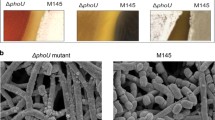Summary
Both PHO80 and PHO85 genes are required to establish the repressed state of the PHO system of Saccharomyces cerevisiae. S1 nuclease protection analysis of the PHO85 transcript revealed that the PHO85 gene contains an intron at the 6th codon of the gene. Each of the fusion proteins, LacZ-Pho80 and LacZ-Pho85, was produced into Escherichia coli and used as an antigen to raise antibodies in a rabbit. Using the affinity-purified antibodies in Western blotting experiments, the PHO85 protein was detected as a 36 kDa and the PHO80 protein as a 34 kDa protein. The PHO80 protein was detected only in extracts prepared from an overproducing strain. The immunoprecipitate containing the PHO85 protein showed protein kinase activity suggesting that PHO85 is a protein kinase gene, which is consistent with the observation that the deduced amino acid sequence of the PHO85 protein resembles that of some protein kinases. The PHO80 protein was found to be phosphorylated in the presence of PHO85 protein.
Similar content being viewed by others
References
Bradford M (1976) A rapid and sensitive method for the quantitation of microgram quantities of protein utilizing the principle of protein dye binding. Anal Biochem 72:248–254
Celenza JL, Carlson M (1986) A yeast gene that is essential for release from glucose repression encodes a protein kinase. Science 233:1175–1180
Celenza JL, Carlson M (1989) Mutational analysis of the SNF1 protein kinase and evidence for functional interaction with the SNF4 protein in Saccharomyces cerevisiae. Mol Cell Biol 9:5034–5044
Cherry JR, Johnson TR, Dollard C, Shuster JR, Denis CL (1989) Cyclic AMP-dependent protein kinase phosphorylates and inactivates the yeast transcriptional activator ADR1. Cell 56:409–419
Courchesne WE, Kunisawa R, Thorner J (1989) A putative protein kinase overcomes pheromone-induced arrest of cell cycling in S. cerevisiae. Cell 58:1107–1119
Cross F, Roberts J, Weintraub H (1989) Simple and complex cell cycles. Annu Rev Cell Biol 5:341–395
Denis CL (1984) Identification of new genes involved in the regulation of yeast alcohol dehydrogenase II. Genetics 108:833–844
Gould KL, Nurse P (1989) Tyrosine phosphorylation of the fission yeast cdc2 + protein kinase regulates entry into mitosis. Nature 342:39–45
Hanks SK, Quinn AM, Hunter T (1988) The protein kinase family: conserved features and deduced phylogeny of the catalytic domains. Science 241:42–52
Kaizer CA, Preuss D, Grisali P, Botstein D (1987) Many random sequences functionally replace the secretion signal sequence of yeast invertase. Science 235:312–317
Laemmli UK (1970) Cleavage of structural proteins during the assembly of the head of bacteriophage T4. Nature 227:680–685
Matsumoto K, Uno I, Ishikawa T (1984) Regulation of repressible acid phosphatase by cyclic AMP in Saccharomyces cerevisiae. Genetics 108:53–66
Miller J (1972) Experiments in molecular genetics. Cold Spring Harbor Laboratory, Cold Spring Harbor, NY
Sherman F, Fink GR, Hicks JB (1983) Methods in yeast genetics. Laboratory manual. Cold Spring Harbor Laboratory, Cold Spring Harbor, NY
Stanley KK, Luzio JP (1984) Construction of a new family of high efficiency bacterial expression vectors; identification of cDNA clones coding for human liver proteins. EMBO J 3:1429–1434
Teague MA, Chaleff DT, Errede B (1986) Nucleotide sequence of the yeast regulatory gene STE7 predicts a protein homologous to protein kinases. Proc Natl Acad Sci USA 83:7371–7375
Toh-e A (1989) Phosphorus regulation in yeast. In: Barr PJ, Brakes AJ, Valenzuela P (eds) Yeast genetic engineering. Butterworth, Boston, pp 44–52
Toh-e A, Shimauchi T (1986) Cloning and sequencing of the PHO80 gene and CEN15 of Saccharomyces cerevisiae. Yeast 2:129–139
Toh-e A, Ueda Y, Kakimoto S, Oshima Y (1973) Isolation and characterization of acid phosphatase mutants in Saccharomyces cerevisiae. J Bacteriol 113:727–738
Toh-e A, Uesono Y, Tanaka K, Wickner RB (1988) PHO85, a negative regulator of the PHO system, is a homolog of the protein kinase gene, CDC28, of Saccharomyces cerevisiae. Mol Gen Genet 214:162–164
Uesono Y, Tanaka K, Toh-e A (1987) Negative regulators of the PHO system in Saccharomyces cerevisiae: isolation and structural characterization of PHO85. Nucleic Acids Res 15:10299–10309
Wek RC, Jackson BM, Hinnebusch AG (1989) Juxtaposition of domains homologous to protein kinases and histidyl-tRNA synthetases in GCN2 protein suggests a mechanism for coupling GCN4 expression to amino acid availability. Proc Nail Acad Sci USA 86:4579–4583
Zoller MJ, Smith M (1983) Oligonucleotide-directed mutagenesis of DNA fragments cloned into M13 vectors. Methods Enzymol 100:468–500
Author information
Authors and Affiliations
Additional information
Communicated by K. Isono
Rights and permissions
About this article
Cite this article
Uesono, Y., Tokai, M., Tanaka, K. et al. Negative regulators of the PHO system of Saccharomyces cerevisiae: characterization of PHO80 and PHO85 . Molec. Gen. Genet. 231, 426–432 (1992). https://doi.org/10.1007/BF00292712
Received:
Issue Date:
DOI: https://doi.org/10.1007/BF00292712




